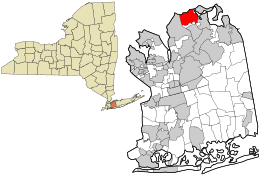Lattingtown, New York
The Incorporated Village of Lattingtown is a village located within the Town of Oyster Bay in Nassau County, New York in the United States. The population was 1,739 at the 2010 census. This area of marsh along the coast was occupied by a band of Lenape, known as the Matinecock, a name associated with the place.
Lattingtown, New York | |
|---|---|
Village | |
| Incorporated Village of Lattingtown | |
 Location in Nassau County and the state of New York. | |
 Lattingtown, New York Location within the state of New York | |
| Coordinates: 40°53′40″N 73°35′42″W | |
| Country | United States |
| State | New York |
| County | Nassau |
| Area | |
| • Total | 3.83 sq mi (9.92 km2) |
| • Land | 3.75 sq mi (9.73 km2) |
| • Water | 0.08 sq mi (0.20 km2) |
| Elevation | 62 ft (19 m) |
| Population (2010) | |
| • Total | 1,739 |
| • Estimate (2019)[2] | 1,764 |
| • Density | 469.77/sq mi (181.36/km2) |
| Time zone | UTC-5 (Eastern (EST)) |
| • Summer (DST) | UTC-4 (EDT) |
| ZIP code | 11560 |
| Area code(s) | 516 |
| FIPS code | 36-41432 |
| GNIS feature ID | 0955075 |
| Website | villageoflattingtown |
The Matinecock sold the area in 1660 to Richard Latting and his son, Josiah Latting. The Lattings sold marsh reeds for use in thatched-roof houses.[3] The same family later established the hamlet of Lattingtown at Marlborough, Ulster County, New York, north of Manhattan.[4]
The 1986 film The Money Pit was filmed partially in Lattingtown.
Geography
Lattingtown is located at 40°53′40″N 73°35′42″W (40.894334, -73.595118).[5]
According to the United States Census Bureau, the village has a total area of 3.8 square miles (9.8 km2), of which, 3.8 square miles (9.8 km2) of it is land and 0.04 square miles (0.10 km2) of it (1.05%) is water.
Demographics
| Historical population | |||
|---|---|---|---|
| Census | Pop. | %± | |
| 1940 | 613 | — | |
| 1950 | 745 | 21.5% | |
| 1960 | 1,461 | 96.1% | |
| 1970 | 1,773 | 21.4% | |
| 1980 | 1,749 | −1.4% | |
| 1990 | 1,859 | 6.3% | |
| 2000 | 1,860 | 0.1% | |
| 2010 | 1,739 | −6.5% | |
| Est. 2019 | 1,764 | [2] | 1.4% |
| U.S. Decennial Census[6] | |||
As of the census[7] of 2000, there were 1,860 people, 627 households, and 509 families residing in the village. The population density was 491.9 people per square mile (190.0/km2). There were 688 housing units at an average density of 182.0 per square mile (70.3/km2). The racial makeup of the village was 94.46% White, 0.59% African American, 3.49% Asian, 0.38% from other races, and 1.08% from two or more races. Hispanic or Latino of any race were 2.31% of the population.
There were 627 households, out of which 37.2% had children under the age of 18 living with them, 73.0% were married couples living together, 5.3% had a female householder with no husband present, and 18.8% were non-families. 16.1% of all households were made up of individuals, and 8.5% had someone living alone who was 65 years of age or older. The average household size was 2.93 and the average family size was 3.25.
In the village, the population was spread out, with 26.2% under the age of 18, 4.6% from 18 to 24, 24.0% from 25 to 44, 31.0% from 45 to 64, and 14.2% who were 65 years of age or older. The median age was 42 years. For every 100 females, there were 93.3 males. For every 100 females age 18 and over, there were 91.5 males.
The median income for a household in the village was $136,807, and the median income for a family was $156,462. Males had a median income of $100,000 versus $44,063 for females. The per capita income for the village was $76,260. About 2.1% of families and 4.5% of the population were below the poverty line, including 1.5% of those under age 18 and 6.6% of those age 65 or over.
Points of interest
- Bailey Arboretum (named after longtime residents Frank and Marie Louise Bailey)
- Underhill Burying Ground, a family cemetery of the Underhills
References
- "2019 U.S. Gazetteer Files". United States Census Bureau. Retrieved July 27, 2020.
- "Population and Housing Unit Estimates". United States Census Bureau. May 24, 2020. Retrieved May 27, 2020.
- "Lattingtown". Newsday. Archived from the original on May 11, 2005. Retrieved 2008-04-12.
Even though fish spawned in the tidal marsh, the Matinecocks apparently drove no hard bargain when they sold much of the area to Richard Latting and his son, Josiah, in 1660. For a while, Josiah Latting had a successful business selling the reeds from the marsh for thatched-roof houses.
- David Ballou; Mary Lou Mahan; L. Garofalini (March 2010). "National Register of Historic Places Registration: Lattintown Baptist Church". New York State Office of Parks, Recreation and Historic Preservation. Archived from the original on 2015-09-24. Retrieved 2010-10-24.
- "US Gazetteer files: 2010, 2000, and 1990". United States Census Bureau. 2011-02-12. Retrieved 2011-04-23.
- "Census of Population and Housing". Census.gov. Retrieved June 4, 2015.
- "U.S. Census website". United States Census Bureau. Retrieved 2008-01-31.